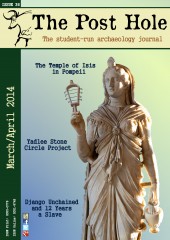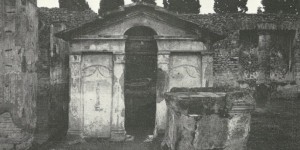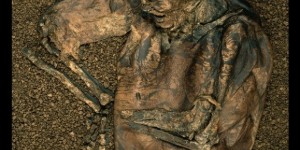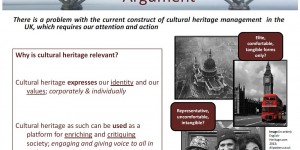I would like to start off by thanking everyone who completed a questionnaire titled ‘The Future of Museums’ for my dissertation. We have reached that time of year again when the dissertation deadline is slowly drawing nearer, and those coming towards the end of University, whether undergraduate or postgraduate, have to decide where they plan to go or which road to take for the future. I am extremely grateful to those who completed the questionnaire and sharing the ‘#callforhelp’ by Facebook or Twitter. I am still in a state of shock, as I did not expect to receive 281 responses within two days of creating the questionnaire. It is extremely beneficial for my dissertation, and it was lovely to hear from people who have the same interests as me, or alternatively disagree that museums face an unstable future.
On the topic of dissertations, the team and I have decided that our last issue, July’s Issue 39, will be a collaboration of articles from the third years that are currently present on the team. This special The Post Hole issue will contain short articles from each of them summing up their experiences as undergraduates, how the ‘dreaded’ dissertations went, the conclusions that were drawn, and what they have planned for after graduation. We hope it will be an interesting issue, but also a wonderful way to say goodbye to this year’s team and welcome the new one. If you would like to become part of the team next year, or become a PR Coordinator at another University, please get in touch. Send your details to editor [at] theposthole.org.
This issue, as you will see, is slightly longer than usual. Due to dissertation deadlines looming, the team have decided to produce a larger issue now, combining March and April’s issues together. With the dissertation deadlines so soon, it would not be feasible to create two individual issues, therefore we hope this seven article issue will suffice. The Post Hole still relies upon your submissions, and the team are already collating them for the May Issue (Issue 37). As always, please send your submissions to Taryn Bell at submissions [at] theposthole.org.
Each of my recent editorials has mentioned the ‘Digging through the Profession of Archaeology’ interview series. As you can see from the title of this editorial, I have decided to refer directly to the interview series for once. This editorial is like no other. Within this issue’s editorial, there is a sneak preview into the next few ‘Digging through the Profession’ interviews we have lined up. This month, we are releasing the interview conducted with Dr. Sarah Walshaw, a historical archaeologist specialising in archaeobotany. Below are a selection of questions we asked our interviewees. Following Dr. Sarah Walshaw, other interviews lined up to be released are conducted with Marilee Wood – bead specialist from Washington State; Jeffrey Fleisher – who works in the Anthropology department at Rice University, Texas; and Amy Downes – a Portable Antiquities Scheme, Finds Liaison Officer for Yorkshire. These brief snippets we hope will give you a flavour of what is lined up for The Post Hole, and how excited we are to be releasing interviews with such a wide selection of people from a variety of professions.
How do you use ethnobotany as a part of your archaeological interpretation? What can it tell us about past societies?
“Ethnobotany, the study of current or recent historic human-plant relationships, can help us understand earlier societies in a few ways. First, collaborations with local peoples can provide information about plant uses, ecologies, and local taxonomies that can help us identify and interpret ancient plant remains. Second, ethnoarchaeological research – particularly concerning agriculture – can connect material patterns to human behaviours; this can provide models for interpreting botanicals in the archaeological record. Third, collecting modern plant specimens helps build a comparative collection with which to aid archaeobotanical identification.” – Dr Sarah Walshaw.
You analyse beads using LA-ICP-MS. What does this mean exactly, and what process do you follow when conducting this analysis?
“I don’t actually do the analysis myself – I send it off to Laure Dussubieux at the Field Museum in Chicago who specializes in this work and has the necessary (and very expensive) equipment. I do need to carefully choose the samples for analysis since it is difficult to get decent results from glass that is corroded. I also need to try to select samples that will provide a good cross-section of the assemblage in question. When the results come in (we get up to 52 oxide, element and trace element values for each sample) I need to work with Laure to figure out how the beads fit into glass types and time frames, and how they compare to other assemblages both nearby and on other continents.” – Marilee Wood.
Your area of interest is African archaeology. How did you become interested in this area?
“Until 1993, I considered myself a historical archaeologist and planned to continue working in the US on colonial period sites. This changed when I, by chance, met Adria LaViolette and she invited me to work on one of her projects in 1993 on Pemba. That season was transformative for me, and I became intrigued by the Swahili coast, a place of cultural contact and rapid social transformation, and the global linkages evident in what were considered remote places. I returned to graduate school in 1995 in Virginia, focusing on rural-urban relationships on first and second millennium Pemba Island, Tanzania.” – Jeffrey Fleisher.
What area of archaeology do you work in?
“I am a small finds specialist working for the Portable Antiquities Scheme (PAS). I specialise in metal artefacts. It is my role to liaise with the public, especially metal detectorists, identify their finds, and record them onto the online PAS database (available at www.finds.org.uk). We will soon have 1 million objects recorded!” – Amy Downes.
The articles within this issue are an eclectic mix, covering a wide range of topics. A number of these articles were submissions to the 2013 ASA conference that was held last year at King’s Manor, York. We thank the authors for being so patient whilst we edited the articles, and are pleased to be able to publish them within this issue. This year, the ASA conference will be held at The University of Reading. If you are interested in presenting a paper or want to become involved, more information can be found at www.asaconference.org.uk.
Imogen Burrell opens this issue with her interesting article on ‘What are non-intrusive archaeological survey techniques, and how are they used to archaeological advantages during excavation’. Burrell also submitted a piece in our previous issue, Issue 35, reflecting on whether the Pitt Rivers Museum is a ‘real’ museum or not. Both of her articles are extremely well written and definitely worth a read.
The Post Hole is excited to announce we have a special and unique article referring to two recent films released, and drawing from Isaak Wilson’s Issue 27 The Post Hole article. Joel Goodchild’s‘Django Unchained and 12 years a Slave: Discourses on the Transatlantic Slave Trade and the Implications of British Colonialism’ is an excellent article and he provides a unique insight into both films, relating them to history and archaeology.
Alex Westra discusses the importance of the discussion group, ‘The Childe Collective’. The group provides a platform for discussion and dissemination of research and ideas in Edinburgh. This exclusive article reflects on the group’s activities and reveals how it can expand and improve.
‘A well-oiled future: Recreating Babylonian oil divination’ written by Alex Loktionov is a thought provoking piece, exploring the most ancient documented form of fortune-telling: Old Babylonian oil divination. Loktionov argues the importance of practical work, and how it provides insight into a psychological framework that is not clear in archaeology.
‘The Temple of Isis in Pompeii: The Promise of Navigable Seas in a Seafaring Economy’ is an exciting and original article. Through a well written article, Kelly Guerrieri emphasises the relationship between the trading economy, the sea and Pompeiian life, and how the success of the sea impacted on the traders and the city’s survival.
One of The Post Hole team editors, Faye Morrissey, gives an interesting take on the archaeology in North-West England, and how it should not be neglected. This article is extremely fascinating and stimulating, and I hope it will generate a lot of responses from our readers.
Finally, Ben Wajdner, a Cultural Heritage Management Masters student completes this issue with an article that is not only attention-grabbing, but provocative and challenging. ‘Cultural Heritage Theory and Practice: raising awareness to a problem facing our generation’ is a topic relevant to today, and like Faye Morrissey’s article, I hope will generate responses and provide The Post Hole with some interesting debates.
We hope you enjoy this issue and if you have any questions or queries, feel free to email me.
Best wishes,
Emily Taylor|
(Editor-in-Chief of The Post Hole - editor [at] theposthole.org)







